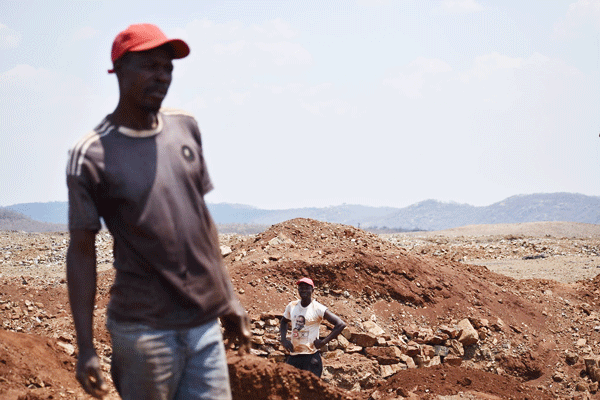
BY ZELA
The mining industry has potential to resuscitate the Zimbabwean economy if the fluid and never-ending macroeconomic, political, human rights and property rights factors and problems are comprehensively addressed by government.
The 2030 vision, which is anchored on mining, is expected to contribute US$12 billion by 2023 by tapping into the gold, platinum, diamond, coal, chrome, copper and other mineral reserves that Zimbabwe is endowed with.
Following years of collapse and closure of large-medium scale companies, some of which are still sitting on valuable mineral resources, and the emergence and increase in the number of artisanal and small-scale miners around the country, there is urgent need to find workable solutions, including political and economic ones, to resuscitate the mining sector that combines the expertise of large-scale companies with artisanal and small-scale mining.
Such a combination is desirable for a mining-based economy like Zimbabwe.
On its part, government has mostly been paying lip service to restoration, capitalisation and opening of closed mines for several years.
This follows closure of many gold, asbestos, chrome and diamond mines around the country.
In the gold sector, artisanal and small-scale miners are currently the largest contributors of gold, the largest foreign currency earner in the country, some of whom are operating at closed gold mine sites including the famous old German mining tunnels in different parts of the country.
- Chamisa under fire over US$120K donation
- Mavhunga puts DeMbare into Chibuku quarterfinals
- Pension funds bet on Cabora Bassa oilfields
- Councils defy govt fire tender directive
Keep Reading
In the above context, the Zimbabwe Environmental Law Association (Zela) gathered information on closed mines around the country to assess the state of play at the mine sites, why and when the companies were closed.
The organisation also took time to assess the levels of artisanal or small-scale mining operations taking place at closed mine sites.
These include mines in the Mberengwa, Zvishavane, Shurugwi, Mazowe, Bindura, Chinhoyi, Mutoko, Masvingo, Mvuma, Penhalonga and Shamva areas.
In the data collection process World Health Organisation guidelines on Covid-19 were observed by the Zela staff.
Key informant interviews were conducted with artisanal and small-scale miners and diggers, large-scale mining company workers, former mine workers and managers.
Additional information was drawn from literature review of online data sources.
As mine visits were conducted during the Covid-19 lockdown period, it was observed that several small-scale and artisanal miners were affected by the Covid-19 pandemic lockdown.
As artisanal small-scale mining is highly labour intensive, the regulations on the novel disease called for a reduction in the number of people working on mining sites which in turn reduced production levels in these mines.
During the mine visits, it was observed that there has been an increase in the number of formalised artisanal small-scale miners into cooperatives, which in turn entered into mining agreements to mine on land belonging to closed mining companies, and this is being done through tributary agreements.
At some closed mine sites, illegal artisanal mining operations are taking place and in some cases such operations involve child participation in mining especially during the height of Covid-19 lockdown and the school closure period.
This has negative implications on the artisanal and small-scale mining value chain.
Sourcing gold from mines operated by children affects the marketing of the mineral.
It was also observed that there is a high number of closed large-scale mines around the country.
Most of these mines were closed due to the poor economic and political environment obtaining in the country or purely mismanagement especially some of the state-owned ones and those under the administration of government-appointed managers.
Some of the mines are operating under judicial management or under the management of the Zimbabwe Mining Development Corporation (ZMDC).
In turn, artisanal miners or small-scale miners are now operating at some mines under tribute agreements entered with the mine owners.
Another observation was that at some of the old mines’ partnerships with artisanal and small-scale miners have been entered into to exploit gold resources, while in some cases former workers are mining illegally for gold, chrome or other minerals.
The machinery and infrastructure at many of the closed mine sites is highly depreciated to be used again.
Retrenched workers from these mines are now working as artisanal miners in these areas, using rudimentary mining tools and methods.
This has become their main source of livelihood or a way to augment the meagre salaries for those still employed to ensure care and maintenance work at closed mines.
There are a number of unresolved conflicts and remuneration issues at many closed mining sites.
l This is an extract from a Zimbabwe Environmental Lawyers Association (Zela) report on the state of closed large and small-scale mines and their relationship with artisanal miners.











